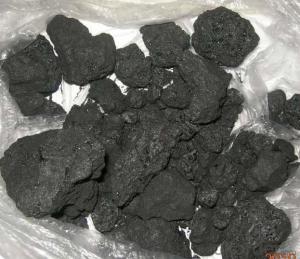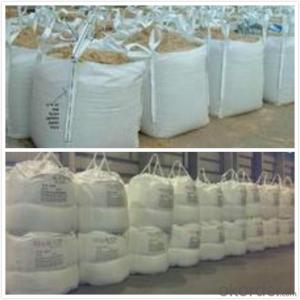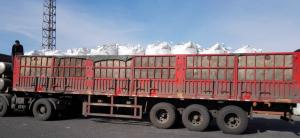Glass Industry Application Carbon Raiser & Calcined Petroleum Coke
- Loading Port:
- Tianjin
- Payment Terms:
- TT OR LC
- Min Order Qty:
- 1 m.t.
- Supply Capability:
- 10000000 m.t./month
OKorder Service Pledge
OKorder Financial Service
You Might Also Like
1.Structure of Calcined Petroleum Coke Description
Calcined Petroleum Coke is made from raw petroleum coke,which is calcined in furnace at a high temperature(1200-1300℃).CPC/Calcined Petroleum Coke is widely used in steelmaking,castings manufacture and other metallurgical industry as a kind of recarburizer because of its high fixed carbon content,low sulfur content and high absorb rate.Besides,it is also a best kind of raw materials for producing artifical graphite(GPC/Graphitized Petroleum Coke) under the graphitizing temperature(2800℃).
2.Main Features of the Calcined Petroleum Coke
High-purity graphitized petroleum coke is made from high quality petroleum coke under a temperature of 2,500-3,500°C. As a high-purity carbon material, it has characteristics of high fixed carbon content, low sulfur, low ash, low porosity etc.It can be used as carbon raiser (Recarburizer) to produce high quality steel,cast iron and alloy.It can also be used in plastic and rubber as an additive.
3. Calcined Petroleum Coke Images
4. Calcined Petroleum Coke Specification
Carbon Additive Graphitized Petroleum Coke Artificial Graphite Scrape Carburizer | F.C (Min) | 99% | 98.5% | 98% |
S (Max) | 0.05% | 0.05% | 0.05% | |
ASH (Max) | 0.5% | 0.80% | 1% | |
V.M(Max) | 0.5% | 0.70% | 1% | |
H2O(Max) | 0.5% | 0.50% | 0.5% | |
Size: | 0.3-5mm,0.5-5mm,1-5mm,3-8mm,ect. | |||
5.FAQ of Calcined Petroleum Coke
1). Q: Are you a factory or trading company?
A: We are a factory.
2). Q: Where is your factory located? How can I visit there?
A: Our factory is located in ShanXi, HeNan, China. You are warmly welcomed to visit us!
3). Q: How can I get some samples?
A: Please connect me for samples
4). Q: Can the price be cheaper?
A: Of course, you will be offered a good discount for big amount.
- Q: What is the role of carbon in respiration?
- Carbon plays a crucial role in respiration as it is a key component of organic molecules such as glucose. During respiration, glucose is broken down in the presence of oxygen to produce energy in the form of ATP. The carbon atoms in glucose are oxidized, releasing electrons that are ultimately transferred to oxygen, forming carbon dioxide (CO2) as a byproduct. This process, known as cellular respiration, occurs in all living organisms and is essential for the production of energy needed for various cellular processes. Without carbon, respiration would not be possible, and the energy required for growth, movement, and other life-sustaining activities would not be generated. Furthermore, the carbon dioxide produced during respiration is released into the atmosphere and serves as a crucial component of the carbon cycle, contributing to the regulation of Earth's climate and the growth of plants through photosynthesis.
- Q: What can light hydrocarbon carbon five be packed with?
- Gas used as a common gas:The light hydrocarbon gas generation device (light hydrocarbon gas generating unit) consists of six basic systems and three safety systems. Includes six basic systems: the host system, fuel supply system, heat system, control system, air system, closed unloading material system. The three major safety systems include ventilation system, lightning protection system, and electrostatic heating system for light hydrocarbon gas.In operation, the working pressure in the gasifier and the static pressure and dynamic pressure of the transmission pipe network are in theBetween 0.01 and 0.02MPa, the normal operating temperature of the gasifier is no more than 45 degrees centigrade, which is lower than that stipulated by the national pressure vessel.
- Q: How does carbon monoxide affect air quality and human health?
- Carbon monoxide, a gas produced when fossil fuels like gasoline, coal, and wood are incompletely burned, is a colorless and odorless substance. It plays a major role in air pollution and has significant impacts on both air quality and human health. Concerning air quality, carbon monoxide is classified as a criteria air pollutant, meaning it is regulated by government agencies due to its harmful effects. When released into the atmosphere, CO combines with other pollutants like nitrogen oxides and volatile organic compounds, resulting in ground-level ozone formation, a key component of smog. High levels of ground-level ozone can cause respiratory issues, particularly for individuals with pre-existing respiratory conditions such as asthma. Moreover, carbon monoxide acts as a potent greenhouse gas, contributing to global warming and climate change. It traps heat in the atmosphere, preventing its escape into space and leading to rising temperatures and altered weather patterns. In terms of human health, carbon monoxide is extremely toxic. When inhaled, it binds to hemoglobin in the blood, reducing its ability to transport oxygen to vital organs and tissues. This can result in various health problems, ranging from mild symptoms like headaches, dizziness, and fatigue to more severe conditions such as chest pain, confusion, and even death. Vulnerable populations, including children, the elderly, and those with pre-existing heart or lung conditions, are particularly susceptible to the detrimental effects of carbon monoxide. Exposure to high levels of carbon monoxide can occur in different settings, both indoors where combustion sources like gas stoves, heaters, and fireplaces are present, and outdoors in areas with heavy traffic or industrial emissions. To mitigate the impact of carbon monoxide on air quality and human health, regulatory measures such as emission standards for vehicles and industrial sources have been implemented. Additionally, raising public awareness through campaigns and utilizing carbon monoxide detectors in homes and workplaces are crucial for detecting and preventing potential exposure to this harmful gas. In conclusion, carbon monoxide significantly impacts air quality and human health. It contributes to air pollution, including the formation of ground-level ozone and greenhouse gas emissions, which have adverse effects on respiratory health, the environment, and climate change. Understanding the sources, effects, and implementing appropriate measures to reduce exposure to carbon monoxide is vital for safeguarding both air quality and human well-being.
- Q: Often see a lot of cars made of carbon fiber body, is this material flammable?
- Carbon fibers are carbonized composites, not burning of their own. Material that belongs to fire protection. But conductive, not insulated.
- Q: How does carbon contribute to global warming?
- Carbon contributes to global warming through the greenhouse effect. When carbon dioxide (CO2) and other greenhouse gases are released into the atmosphere, they trap heat from the sun and prevent it from escaping back into space. This leads to an increase in the Earth's surface temperature, causing global warming. The primary source of carbon emissions is the burning of fossil fuels such as coal, oil, and natural gas for energy production, transportation, and industrial processes. These activities release large amounts of CO2 into the atmosphere, which accumulates over time and enhances the greenhouse effect. Additionally, deforestation and land-use changes also contribute to rising carbon levels. Trees and plants absorb CO2 as part of photosynthesis, acting as a natural carbon sink. However, when forests are cleared, this stored carbon is released back into the atmosphere. Moreover, the loss of trees reduces the overall capacity to absorb CO2, exacerbating the problem. The consequences of increased carbon emissions are far-reaching. Rising temperatures result in the melting of polar ice caps and glaciers, leading to sea-level rise and threatening coastal communities. Furthermore, carbon-driven global warming disrupts weather patterns, causing extreme weather events such as hurricanes, droughts, and heatwaves. To mitigate the impact of carbon on global warming, efforts must be made to reduce carbon emissions. This can be achieved through transitioning to renewable energy sources like solar and wind, improving energy efficiency, promoting sustainable practices in agriculture and forestry, and implementing policies that encourage carbon capture and storage. Addressing carbon emissions is crucial in combating global warming and its associated consequences. By understanding the role of carbon in the greenhouse effect, we can work towards a sustainable future that minimizes the harmful effects of climate change.
- Q: What are the impacts of carbon emissions on human respiratory diseases?
- Human respiratory diseases are significantly affected by carbon emissions, especially those resulting from the burning of fossil fuels. The release of carbon dioxide and other greenhouse gases into the atmosphere contributes to climate change, which in turn impacts air quality and worsens respiratory conditions. One of the main outcomes of carbon emissions is the rise in air pollution. When fossil fuels are burned, various pollutants such as nitrogen oxides, sulfur dioxide, and particulate matter are released. These pollutants can irritate and harm the respiratory system, triggering and worsening respiratory diseases like asthma, bronchitis, and chronic obstructive pulmonary disease (COPD). They can also lead to the development of respiratory infections and reduce lung function, making individuals more susceptible to respiratory illnesses. Respiratory health is further affected by climate change, which is fueled by carbon emissions. As temperatures rise and weather patterns change, allergens and air pollutants proliferate, causing more frequent and severe allergic reactions and exacerbating respiratory conditions. Climate change can also extend the pollen season and increase the production of mold spores, leading to asthma attacks and other respiratory symptoms. Additionally, carbon emissions contribute to the creation of ground-level ozone, a harmful pollutant. Climate change enhances the chemical reactions that produce ozone due to higher temperatures and increased sunlight. Ground-level ozone can irritate the airways, resulting in coughing, shortness of breath, and chest pain. It can also worsen existing respiratory diseases and impair lung function, particularly in vulnerable populations such as children, the elderly, and individuals with pre-existing respiratory conditions. In conclusion, the impact of carbon emissions on human respiratory diseases is significant. They contribute to air pollution, which worsens respiratory conditions and increases the risk of respiratory infections. Furthermore, climate change, driven by carbon emissions, intensifies the production of allergens and air pollutants, exacerbating respiratory symptoms and reducing lung function. It is crucial to implement effective measures to reduce carbon emissions not only to address climate change but also to protect respiratory health.
- Q: How does carbon contribute to air pollution?
- Air pollution is primarily caused by carbon, which emits carbon dioxide (CO2) and carbon monoxide (CO) into the atmosphere. The burning of fossil fuels like coal, oil, and natural gas releases large quantities of carbon dioxide, a greenhouse gas responsible for global warming and climate change. This excess CO2 traps heat in the atmosphere, resulting in the greenhouse effect and a subsequent increase in global temperatures. Moreover, incomplete combustion of fossil fuels and biomass can release carbon monoxide, a toxic gas with harmful effects on human health. Carbon monoxide is especially dangerous because it binds to hemoglobin in the blood, reducing its ability to carry oxygen and potentially causing asphyxiation. Furthermore, carbon-containing compounds, such as volatile organic compounds (VOCs), also contribute to air pollution. These VOCs are released from various sources, including industrial processes, vehicle emissions, and the use of solvents in paints and cleaning products. When these compounds react with other pollutants in the atmosphere, they form ground-level ozone, a major component of smog. Inhaling ozone can lead to respiratory issues, eye irritation, and other health problems. In summary, carbon plays a significant role in air pollution by emitting carbon dioxide, carbon monoxide, and volatile organic compounds. These pollutants have profound impacts on climate change, human health, and the overall quality of the air we breathe. It is crucial to reduce carbon emissions and adopt sustainable practices to mitigate the adverse effects of carbon on air pollution.
- Q: What is carbon black filler?
- Carbon black filler is a type of material made from fine particles of carbon that is added to various products, such as rubber, plastics, and inks, to improve their strength, durability, and color.
- Q: How does carbon impact the melting of polar ice caps?
- The primary way in which carbon affects the melting of polar ice caps is through climate change. Carbon dioxide, a greenhouse gas, traps heat in the atmosphere and causes the Earth's temperature to rise. This rise in temperature leads to the melting of polar ice caps. Human activities, such as burning fossil fuels, deforestation, and industrial processes, release carbon into the atmosphere. This carbon accumulates and contributes to the greenhouse effect. As the concentration of carbon dioxide increases, more heat is trapped, resulting in global warming. The warming caused by carbon has a particularly detrimental effect on polar ice caps, especially those in the Arctic and Antarctica. Rising temperatures accelerate the melting of the ice caps, causing them to shrink and eventually collapse. This process is known as ice cap retreat. The impact of carbon on polar ice caps is two-fold. Firstly, the melting of ice caps contributes to rising sea levels, which poses a significant threat to coastal communities and low-lying areas worldwide. As the ice caps melt, the water flows into the oceans, causing them to expand. This can result in coastal erosion, increased flooding, and the loss of valuable habitats and ecosystems. Secondly, the melting of polar ice caps also disrupts the delicate balance of the Earth's climate system. The reflective surface of ice helps regulate the planet's temperature by reflecting sunlight back into space. However, as the ice melts, it is replaced by darker surfaces that absorb more heat, such as water or land. This further intensifies global warming, creating a feedback loop that accelerates the melting process. Overall, the impact of carbon on the melting of polar ice caps is significant. The continuous release of carbon into the atmosphere contributes to the loss of these crucial ecosystems, leads to sea-level rise, and disrupts the Earth's climate system. To mitigate these effects, it is crucial to reduce carbon emissions and transition to cleaner and more sustainable sources of energy.
- Q: What are the applications of graphite in industry?
- Graphite possesses distinct properties that make it suitable for a range of applications across industries. Here are several key uses of graphite in different industrial sectors: 1. Lubricants: Given its low friction coefficient, graphite is extensively employed as a solid lubricant in industries that encounter high temperatures and extreme pressures, like automotive, aerospace, and heavy machinery. 2. Refractories: Graphite's exceptional heat and chemical resistance make it an ideal material for manufacturing refractory products. It helps line furnaces, crucibles, and other high-temperature equipment in metal production, glass manufacturing, and chemical processing. 3. Electrical industry: Graphite's excellent electrical conductivity makes it widely utilized in this sector. It is employed to produce electrodes, brushes, and contacts for electrical motors, generators, and batteries. Furthermore, graphite serves as a component in electrical discharge machining (EDM) and conductive paints and coatings. 4. Foundry industry: Graphite acts as a mold and core material in the foundry industry, owing to its high thermal conductivity and ability to withstand high temperatures. It finds application in various metal casting processes, including sand casting, investment casting, and continuous casting. 5. Chemical industry: The chemical industry benefits from graphite's corrosion resistance and capacity to endure high temperatures. It is utilized in the manufacture of chemical equipment such as heat exchangers, reactors, and pipes, where it can withstand aggressive chemical environments. 6. Nuclear industry: In the nuclear industry, graphite serves as a moderator in nuclear reactors. Its ability to slow down neutrons allows for controlled nuclear fission reactions. Additionally, graphite is employed as a structural material in certain types of nuclear reactors. 7. Composite materials: Graphite is frequently used as a reinforcement material in the production of composite materials. By combining graphite fibers or sheets with resins or metals, lightweight and high-strength composites are created for applications in aerospace, automotive, and sporting goods industries. In conclusion, graphite's unique properties, encompassing high thermal and electrical conductivity, lubricity, and chemical inertness, contribute to its versatility as a material with diverse applications across industries.
Send your message to us
Glass Industry Application Carbon Raiser & Calcined Petroleum Coke
- Loading Port:
- Tianjin
- Payment Terms:
- TT OR LC
- Min Order Qty:
- 1 m.t.
- Supply Capability:
- 10000000 m.t./month
OKorder Service Pledge
OKorder Financial Service
Similar products
Hot products
Hot Searches
Related keywords































